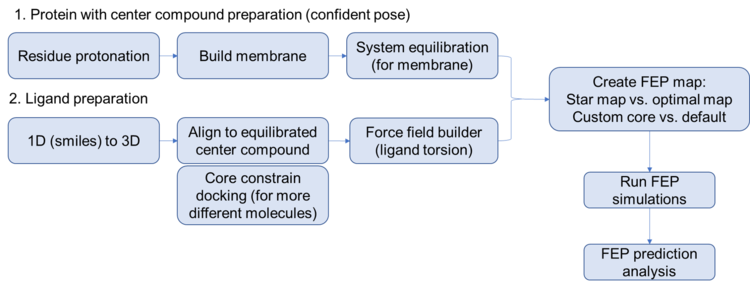FEP+ for GPCR: Difference between revisions
No edit summary |
No edit summary |
||
| Line 4: | Line 4: | ||
[[File:workflow_FEP.png|thumb|center|750px]] | [[File:workflow_FEP.png|thumb|center|750px]] | ||
* Build membrane with | == Protein side == | ||
Carefully look into the binding site and make sure the residues are correctly protonated... | |||
'''Protein model completeness''' | |||
Protein preparation should include fixing any chain breaks, modeling in any loop conformations and adding any missing side chains. Chain breaks near the active site will likely lead to poor results. Disulfide bridges should be created and termini residues capped where applicable. | |||
* Build membrane with system builder (build the POPC membrane, add salts, add solvent) | |||
res.num 76-97,112-136,141,143,146-171,194-215,227-229,231-256,323-345,347,360-380,382,398 | |||
* Equilibration of complex structure (with confident binding pose) | * Equilibration of complex structure (with confident binding pose) | ||
Visualize trajectory and with SID tool | |||
* Convert -out.cms into mae | |||
$SCHRODINGER/run membrane_cms2fep.py -ligand 'ligand' 2A_NBOH_MD-out.cms -o relax_2A_NBOH_pv.mae | |||
== Ligand side == | |||
Careful preparation of the ligands is critical to a successful FEP+ prediction. Best practices include running LigPrep on all the compounds to exhaustively enumerate all the stereoisomers and likely protonation states of the ligands. Note that triply-substituted ammonium cannot invert stereochemistry during the simulation, making it important to model both pseudo-stereoisomers. | |||
* Force field builder | * Force field builder | ||
Revision as of 22:16, 8 March 2021
2/25/2021 Ying Yang
Steps for setting up a FEP prediction for membrane protein
Protein side
Carefully look into the binding site and make sure the residues are correctly protonated...
Protein model completeness Protein preparation should include fixing any chain breaks, modeling in any loop conformations and adding any missing side chains. Chain breaks near the active site will likely lead to poor results. Disulfide bridges should be created and termini residues capped where applicable.
- Build membrane with system builder (build the POPC membrane, add salts, add solvent)
res.num 76-97,112-136,141,143,146-171,194-215,227-229,231-256,323-345,347,360-380,382,398
- Equilibration of complex structure (with confident binding pose)
Visualize trajectory and with SID tool
- Convert -out.cms into mae
$SCHRODINGER/run membrane_cms2fep.py -ligand 'ligand' 2A_NBOH_MD-out.cms -o relax_2A_NBOH_pv.mae
Ligand side
Careful preparation of the ligands is critical to a successful FEP+ prediction. Best practices include running LigPrep on all the compounds to exhaustively enumerate all the stereoisomers and likely protonation states of the ligands. Note that triply-substituted ammonium cannot invert stereochemistry during the simulation, making it important to model both pseudo-stereoisomers.
- Force field builder
Run force field builder for all ligands
- Flexible ligand alignment OR core constrain docking
Depends on how similar/different are the ligands to the reference/center ligand
- Create FEP maps
- Write out the submission file; change host; submit on gimel5 via slurm
